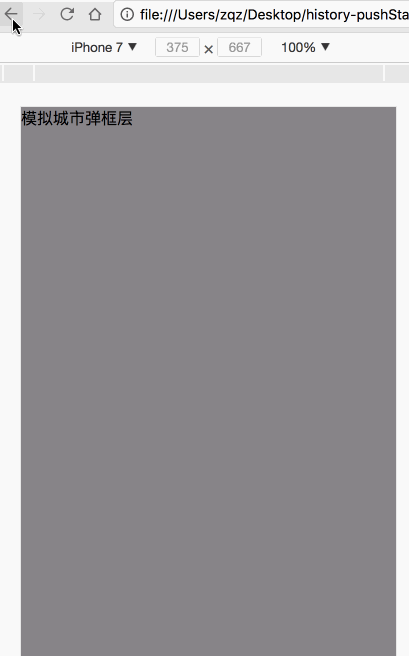您好,登錄后才能下訂單哦!
您好,登錄后才能下訂單哦!
小編給大家分享一下Html5頁面中如何實現返回,希望大家閱讀完這篇文章之后都有所收獲,下面讓我們一起去探討吧!
看到這個題目你可能覺得這是什么鬼? 其實我想說的是這種,看下面的錄制:

這種交互在H5頁面中比比皆是,點擊城市->彈出城市選擇浮層->按返回按鈕關閉浮層。
這些操作都是不要點擊左上角/右上角的關閉按鈕就可以進行的,飛豬的H5是前進出現彈層,返回時彈層關閉,其他家都不行(去哪兒網H5飛機票,美團H5酒店)。
為什么要這么設計?
因為H5是在手機上操作的,手機上的手指可操作區域的覆蓋范圍很小,更別說左上角/右上角這些死角(取消/關閉)區域了。你肯定聽過這個操作:輕觸返回。這個在用戶操作的時候非常方便友好,選擇完城市后,不需要點擊取消,直接在大拇指可以操作的地方點擊返回就關閉了彈層。
如何實現
既然有這種非常好的需求,那作為開發肯定就會想法設法的實現這個功能了。 你甚至都不用google,你就應該會想到類似的history.back(),history.go()這些方法了。 然而想到這些依舊沒用,理論上 瀏覽器/webview 的返回/前進的是要重新加載頁面的,因為URL發生了變化。 如果你真的知道單頁面應用(SPA),或者使用React/Vue你就應該知道有個東西叫:路由。 這些通過改變hash且無法刷新的url變化是HTML5時加入的history功能
the-history-interface
interface History {
readonly attribute unsigned long length;
attribute ScrollRestoration scrollRestoration;
readonly attribute any state;
void go(optional long delta = 0);
void back();
void forward();
void pushState(any data, DOMString title, optional DOMString? url = null);
void replaceState(any data, DOMString title, optional DOMString? url = null);
};pushState
replaceState
還有一個事件
onpopstate
pushState,replaceState 用來改變histroy堆棧順序,onpopstate 在返回,前進的時候觸發
vue-router中的實現也是如此(第1694行)
具體實現
既然說了這么多,那我們來看下怎么實現這種功能。
來看下 pushState 和 replaceState 的兼容性

全綠,用起來放心多了。
思路:
點擊彈層時 pushState 添加 hash
"輕觸返回"的時候觸發 onpopstate 事件時候隱藏彈層并修改 hash
<button onclick="city()"> 城市 </button><br> <button onclick="calendar()"> 日歷 </button><br> <button onclick="description()"> 說明 </button> <div id="city" class="com" style="display: none;"> 模擬城市彈框層 </div> <div id="calendar" class="com" style="display: none;"> 模擬日歷彈框層 </div> <div id="description" class="com" style="display: none;"> 模擬說明彈框層 </div>
button {
border: #0000;
background-color: #f90;
}
.com {
position: absolute ;
top: 0;
bottom: 0;
left: 0;
right: 0;
background-color: #888589;
}var cityNode = document.getElementById('city');
var calendarNode = document.getElementById('calendar');
var descriptionNode = document.getElementById('description');
function city() {
cityNode.style.display = 'block';
window.history.pushState({'id':'city'},'','#city')
}
function calendar() {
calendarNode.style.display = 'block';
window.history.pushState({'id':'calendar'},'','#calendar')
}
function description() {
descriptionNode.style.display = 'block';
window.history.pushState({'id':'description'},'','#description')
}
window.addEventListener('popstate', function(e){
// alert('state:' + e.state + ', historyLength:' + history.length);
if (e.state && e.state.id === 'city') {
history.replaceState('','','#');
cityNode.style.display = 'block';
} else if (e.state && e.state.id === 'calendar') {
history.replaceState('','','#');
calendarNode.style.display = 'block';
} else if (e.state && e.state.id === 'description') {
history.replaceState('','','#');
descriptionNode.style.display = 'block';
} else {
cityNode.style.display = 'none';
calendarNode.style.display = 'none';
descriptionNode.style.display = 'none';
}
})主要看 JS 代碼,監聽頁面的前進和后退事件來控制history。

看完了這篇文章,相信你對“Html5頁面中如何實現返回”有了一定的了解,如果想了解更多相關知識,歡迎關注億速云行業資訊頻道,感謝各位的閱讀!
免責聲明:本站發布的內容(圖片、視頻和文字)以原創、轉載和分享為主,文章觀點不代表本網站立場,如果涉及侵權請聯系站長郵箱:is@yisu.com進行舉報,并提供相關證據,一經查實,將立刻刪除涉嫌侵權內容。